danbricklin.com/log
|
||
|
|
Starting June 26, 2002
Perl program for showing HTML source, Slow week here but full on SATN.org, A short visit to TechXNY (PC Expo)
26Jun02-10Jul02
2002_06_26.htm
|
|
|
Perl program for showing HTML source [link]
As part of my research into small businesses and their Internet needs, I decided to take a piece of "traditional" Internet software (an open source Perl program for running on a server) and distribute it using a web site (free download and for-fee CDROM). A test version of the download is now available.
A few things: This is my first Perl program. (Be kind...) The object was to do something simple and go through the whole process. I assume that the person downloading this knows what they are doing. They should know Perl and their system, and how not to use it (e.g., the program wasn't designed or tested for use as a service for the general public and doesn't test arguments).
What does it do? Called SRCSVC (for "Source listing Service"), you invoke it with a bookmarklet when looking at a web page in a browser. (A "bookmarklet" is a normal browser Bookmark or Favorite that runs Javascript instead of going directly to a URL. Lots of useful ones are at www.bookmarklets.com.) The bookmarklet (often named "Show Source") sends the URL of the page you are looking at to a server running SRCSVC which returns a page that pops up in a new browser window showing the source. The text is nicely (I think) wrapped, with references to other URLs set to display their source when clicked (letting you look at external CSS or Javascript source, frames in a frameset, etc.), and more. Source display is such a personal thing that I thought an open source program for doing it would be helpful to many people.
In order to use SRCSVC you need to have access to a server that runs Perl CGI (most servers) and the appropriate libraries (all generally available). To try it (and see a sample and more details) look at "Software Garden SRCSVC" and let me know what you think.
Slow week here but full on SATN.org [link]
I've devoted what little time I have for blogging to working with Bob Frankston on his SATN.org postings (Bob's writing style requires a careful proofreader). SATN has been dormant for a while, but suddenly it has five postings (some quite long) in three days. They're worth reading.
A short visit to TechXNY (PC Expo) [link]
Monday night I took the Amtrak Acela Express down to New York City and yesterday I attended the TechXNY "event", better known as PC Expo (but now with some sister shows, too). The Acela is a fast train that is very competitive with airplanes when going to New York from Boston. Lots of room, 120 V AC for all seats, 3 1/4 hours sitting and working (4 hours door-to-door vs. 3 1/2 for an on-time plane with no more than 2 hours using a laptop or reading). When I left, there were still worries that Amtrak would shut down Wednesday (I happened to be scheduled to return Tuesday night on the last Acela north). A camera crew had set up on the train platform for the evening news:
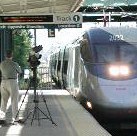  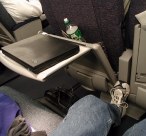 Train pulling into station next to local news crew, A/C power outlet and seat trays on Amtrak Acela
The main keynote Tuesday morning was Jeff Raikes, Group Vice President of Productivity & Business Services at Microsoft. He covered three main areas in his talk: Office 11, Tablet PCs, and Pocket PC Phone Edition. He said little about Office 11 other than it will be available in about a year and that they'd dribble out details over that period. Key areas: "Big investments in XML, meeting innovations, notetaking, personal information breakthroughs." He showed a screen shot:
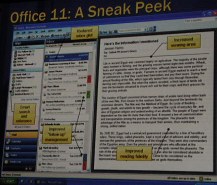 Office 11 sneak peek. Call outs: Smart search and reference, reduced inbox glut, improved "follow-up" management, increased viewing area, and improved reading fidelity.
The bulk of the talk was about Tablet PC. He announced that they would officially launch it on November 7th, 2002. He did lots of demos of sample units and applications. (No big surprises. Actually, no big surprises compared to software we were doing in the old Pen Windows days 7 years ago. Sigh.) There's a big emphasis from Microsoft on doing notetaking, using ink as a communications data type (though I'd have a hard time reading much of his or many other people's handwriting written normal sized and smoothed as they were showing in these early units), and using a pen for text input (on-screen keyboard or handwriting recognition). There was very little mention of what I think is a major reason to use a Tablet PC (as a screen-flipping convertible): Much of what we do is read, especially web pages and Office documents. Even a lot of email is reading. Even with the "lousy" screens and fonts we have today we read a lot. All you need input for is to click on links and menus, and use the scroll bars -- both something a pen does quite nicely. With 802.11, the form factor of a tablet is a win. You can carry it around or use it in many orientations, situations in which an opened laptop is very awkward. When you need to do anything else, you just turn the tablet into a normal laptop with a twist of the screen and set it down. Tablet computers have needed to wait for wireless LANs and the Web to have a reason to be. Since I use both, I wish I could get a Tablet PC now. Once lots of us have PCs with pen input, we'll see lots of innovation in the pen side again.
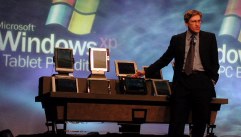 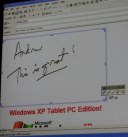 Jeff Raikes showing off some Table PCs, replying to an email with some ink
The last part of the keynote was about the new Pocket PC Phone Edition being launched this summer with Voicestream (GSM to start again like the Treo, I guess...). Product Manager Craig Dewar showed an "empty" unit sync'ing with Exchange on a GPRS wireless connection, and then doing normal stuff like making calls, taking a call in the middle of playing a media file, etc.
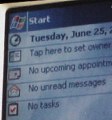 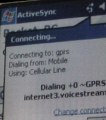   Using GPRS wireless to synchronize an empty Pocket PC Phone with Exchange
Right after the keynote was a panel that I participated in: 20 Year Milestone. "As PC Expo celebrates its 20th anniversary, respected executives and technologists reflect on 20 years of IT solutions, with an eye to the future." CRN editor Heather Clancy put together and co-moderated the panel with VARBusiness' David Strom. Participants included Larry Birenbaum VP of Cisco, Marilyn Edling VP of HP, David Nagel CEO of PalmSource, Chris Stone Vice Chairman of Novell, and me -- a very good set of people for the topic. After talking about the old PC we loved most (to get the "old" over with) we discussed tablets, what needs to happen, infrastructure, authentication, platforms (especially LINUX), and more.
 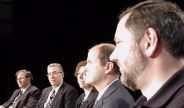 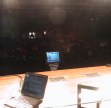 My view on stage of Heather Clancy and the rest of the panel. You can't see the audience much when the lights come up
After the panel I went to visit Trellix's booth in the Web Services Edge part of the "event". We had just made an announcement about a major upgrade to our offerings (giving us the "...most complete suite of integrated web site building, site promotion and business services for small business") and I needed to help with a few press meetings. At our booth I ran into a visitor: James Hong. He's best known as founder and CEO of www.HotOrNot.com, an application I've cited as a great example of neat design and "cornucopia of the commons" architecture (where individuals selfishly doing what they want improve things for all). He was in town as a celebrity and an exhibitor at the XMethods' booth. We had some interesting conversations. He's got some great things coming...
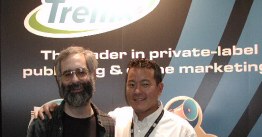 Me with James Hong of HotOrNot in the Trellix booth (James was kind enough to suggest the location so I could get in the plug for Trellix...)
I got a little time to walk the show floor. (Not overwhelming in size, but not small enough that I could hit more than a tiny percentage of the booths.) Microsoft had about a couple dozen Pocket PC Phones laying around (on security cables) that you could just pick up and use (including making calls). Really nice. Too bad it doesn't have a keyboard like the Treo. That was a glaring problem -- all these cools apps to use for communications yet no quick way to input without pulling out the pen and using two hands (a lot of Treo use can be done one-handed). Again, like the Treo, it's getting into UIs where phone call operations like conference calling are understandable.
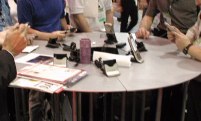  People trying the Microsoft phones, a unit with stubby antenna
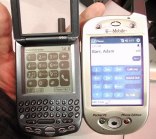 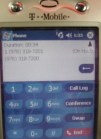 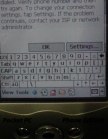 Size comparison with a Treo 180, call screen with one call on hold, on-screen keyboard (it also does handwriting recognition but the pens were missing and it's hard to write accurately with a fingernail though I did succeed a bit)
A couple of other things I got pictures of: Toshiba showed their "portable wireless network" -- a 10 pound Linux box with WiFi, along with light laptops and stuff. They are aiming the box at system integrators to build turnkey, easy to install small business systems, as well as for consulting, demoing, training, and other applications where you need to setup a full system easily. (They also showed some uses with MP3s in a home and remote cameras.) In other booths there were various battery options for laptops, digital cameras/camcorders, and cell phones. One sub-2 pound Lithium-ion unit claims to power a laptop for 16 hours.
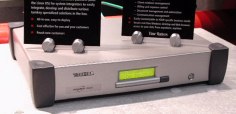 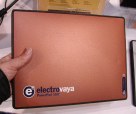 Toshiba Magnia SG20 server/WiFi access point combination, Electro-vaya long-life battery
That's it. I wrote most of this on the Acela back Tuesday night. Apparently (I looked at the latest news on my Treo while riding) Amtrak is not stopping operation Wednesday so it wasn't the last train to Boston...
|
||
|
© Copyright 1999-2018 by Daniel Bricklin
All Rights Reserved.
|
||